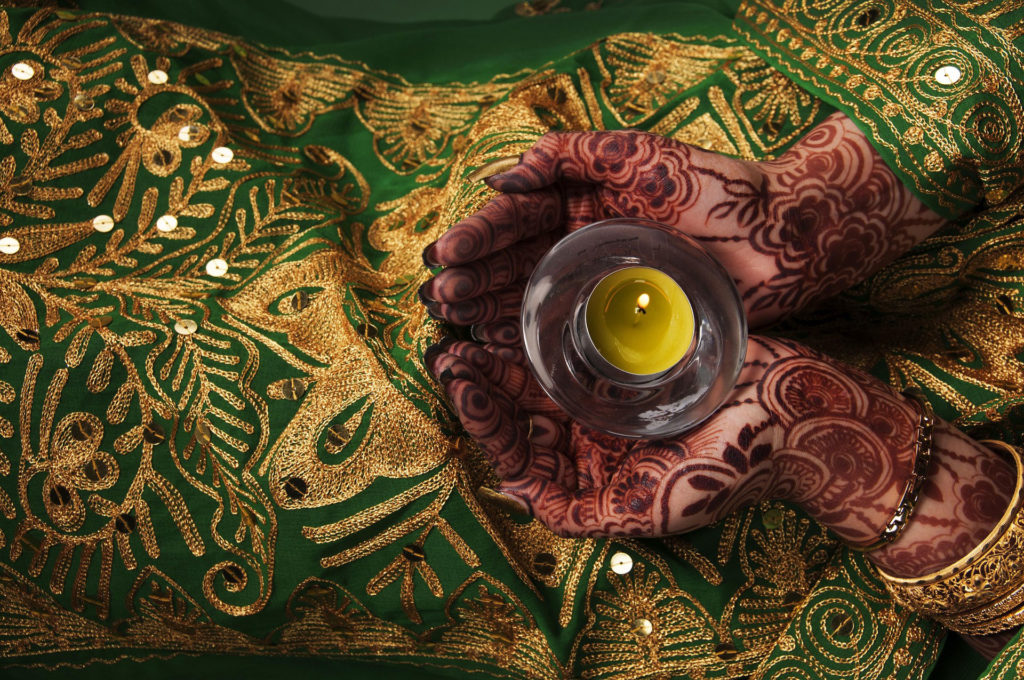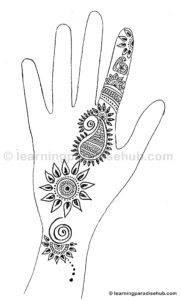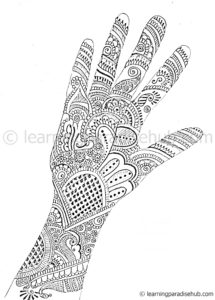 Mehndi (Hindi: मेहंदी, Urdu: مہندی) is the art of painting hands or feet, or the body, with a paste made of dried henna leaves. A spot of bright red to dark brown was created but this color is prone to discoloration with the time and strength and quality of the paste you make. The oils can be added to help the rich shade, but are not necessary.
Mehndi (Hindi: मेहंदी, Urdu: مہندی) is the art of painting hands or feet, or the body, with a paste made of dried henna leaves. A spot of bright red to dark brown was created but this color is prone to discoloration with the time and strength and quality of the paste you make. The oils can be added to help the rich shade, but are not necessary.
 Mehndi began in Egypt more than 5000 years ago and has been used for various artistic and religious purposes ever since. In Egypt, archaeologists also found on the henna hands of the mummy. In the West, it has become popular as a temporary tattoo. Without pain and relatively inexpensive, Mehndi is-it-yourself kits that can be ordered online or in stores in the United States.
Mehndi began in Egypt more than 5000 years ago and has been used for various artistic and religious purposes ever since. In Egypt, archaeologists also found on the henna hands of the mummy. In the West, it has become popular as a temporary tattoo. Without pain and relatively inexpensive, Mehndi is-it-yourself kits that can be ordered online or in stores in the United States.
Different cultures have created different styles of applications. If popular geometric patterns in North Africa or the beautiful designs from India and Pakistan are created by applying the paste to the skin. Allow the skin to dry out paste imperfections and brings the vibration of colors.
Because the application of henna is the practice of traditional women, there is a lack of historical documentation on its use. In cultures that Mehndi was popular, women are not officially educated and information has been passed down through oral communication. Only in recent history that information and documents have begun to appear in this beautiful and rich tradition.
Traditional weddings in India are the opportunities for brides to decorated with henna. The Hindu tradition calls the bride and groom to attend the henna painting, as well as family and friends. This event before the royal wedding is a celebration of Mehndi art as he paints the bride with traditional symbols that can make a festive atmosphere.
 The practice of mehndi in Muslim countries is to apply it on Eid Festival which is at the end of Ramadan, the month of Islamic fasting, with henna tattoos. These models celebrate the success of Ramadan, which includes abstinence pay attention to their physical appearance and beauty. To celebrate the artists paint complicated Mehndi patterns on Muslim women.
The practice of mehndi in Muslim countries is to apply it on Eid Festival which is at the end of Ramadan, the month of Islamic fasting, with henna tattoos. These models celebrate the success of Ramadan, which includes abstinence pay attention to their physical appearance and beauty. To celebrate the artists paint complicated Mehndi patterns on Muslim women.
Although henna has been used as a celebration event for generations, the important thing to remember about Mehndi is that it is a social event. Friends and family can come together to apply henna tattoo, not for religious or ritual purposes, but as a way to socialize and create beauty. Social methods and making friends or family are a great way to show your feelings towards that person. Being decorated with henna is a great way to show that you trust the person decorated.
DIY kits and templates are available and you can create yourself to show this beautiful expression of his art. Friends will be happy to show complex patterns that you create. We have vast variety of complex and simple mehndi designs on our website. You can look into it and get some inspirations.

One comment on “Mehndi Designs: A Brief History of Mehndi”
You can get more beautiful mehndi designs
Visit: https://girlzhack.com/ensure-that-your-mehendi-is-dark-and-beautiful/